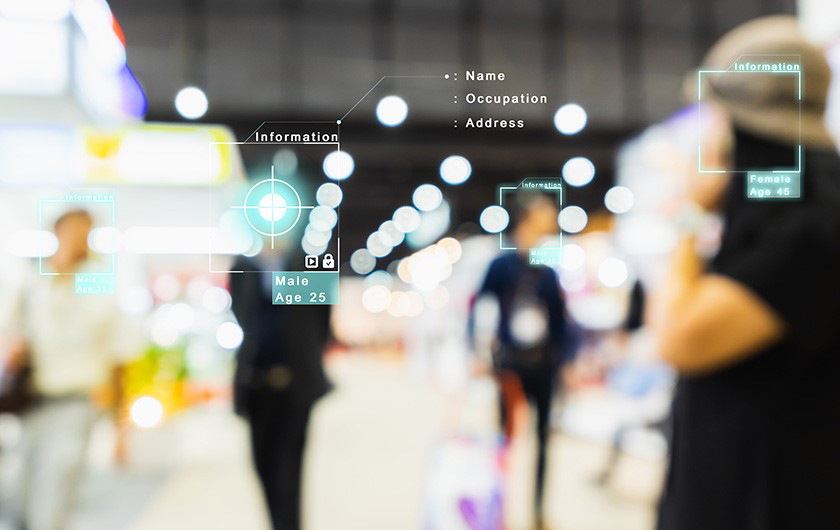
Contents
- Detecting suspicious activity in real time
- Time and effort to collect training data
- AI recognizes complex behavior in a short period of time
- Analyzing types, orders and locations of suspicious actions
- 100 per cent detection accuracy
- Applications beyond crime prevention
Detecting suspicious activity in real time
Many surveillance cameras have been installed in stations, commercial facilities, and city areas to deter crime. However, as the number of cameras increases, the volume of video data has also become massive. This makes it almost impossible for the police and security companies to visually monitor for suspicious behavior and crime by checking and analyzing images and videos manually. To address this challenge, artificial intelligence (AI) is being used in the fight against crime.
AI is supporting remote monitoring 24 hours a day, 365 days a year through improving the accuracy of video data analysis, which allows real-time detection and reporting of suspicious activity. Surveillance cameras, which had mainly been installed for recording and acting as a deterrent to crime, can now be used for predictive detection and crime prevention.
Police services around the world are actively working to use AI for video analysis and criminal investigation, with a move toward predictive crime detection and prevention based on the concept of proactive, rather than reactive, crime fighting.
Time and effort to collect training data
There are some challenges in deploying AI to analyze surveillance camera footage. For AI to recognize suspicious behavior, such as someone checking out a house, it is necessary to prepare a large amount of training video data that records complex target behaviors. Collecting videos that capture suspicious behaviors requires great time and effort.
Also, an AI that is already trained to recognize certain behaviors needs to re-learn a huge amount of video data to recognize new target behaviors. It is difficult to improve the accuracy of an AI's analysis, while customizing it to learn new suspicious behaviors through continuous training. These challenges can hinder the progress of AI deployment in the field.
AI recognizes complex behavior in a short period of time
To address the challenge of deploying AI for crime prevention, Fujitsu has developed behavioral analysis technology called “Actlyzer”. Actlyzer recognizes complex behaviors from multiple basic actions or movements, without making the AI learn a large amount of video data.
With this technology, the AI learns around 100 types of movements as basic actions in advance; from simple actions such as walking and stopping, to more complex movements and actions such as turning the head to the right and raising the left hand. These basic actions can be recognized with an average accuracy of 90 percent or more through deep learning.
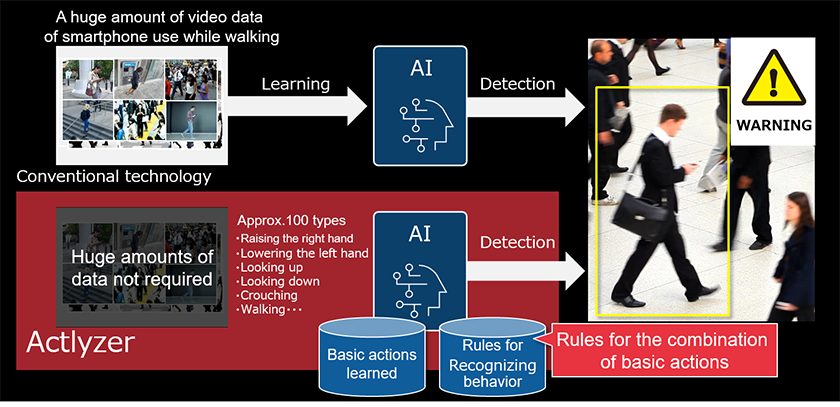
Actlyzer can recognize complex behavior
in a short period of time by combining basic actions learned by AI
Analyzing types, orders and locations of suspicious actions
Actlyzer can detect complex behavioral patterns, such as suspicious behavior, by analyzing combinations of types, order, and place of basic actions as well as the target of actions.
For example, in detecting lock-picking, it is possible to identify potentially suspicious behavior by specifying combinations of basic actions or movements. Such a combination might be: "positioned in front of a door, sitting, looking at the keyhole, and reaching for the keyhole." Conditions might also be added, such as the place of occurrence and the target of actions.
Recognition accuracy of suspicious behavior can be further refined after the system's introduction. This can be done by specifying additional behavioral conditions, such as turning the head left and right to look around, and by changing analysis parameters, such as each action’s duration.
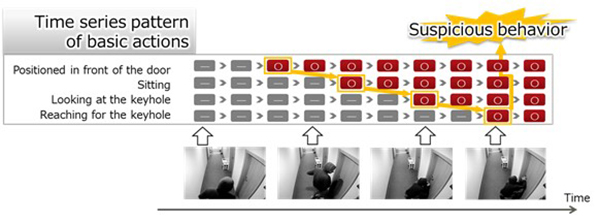
Detecting suspicious behavior by analyzing combinations of basic actions, place of occurrence, and target of actions without large amounts of training data
100 per cent detection accuracy
Fujitsu conducted an experiment to measure the degree of accuracy of its Actlyzer to detect suspicious behavior. The experiment used 21 types of video data taken both indoors and outdoors, with Actlyzer successfully identifying all eight kinds of targeted suspicious behavior (checking out a house, wielding a weapon, etc.).
It took only one day to create rules for the combination of basic actions needed to detect these eight types of suspicious behavior. For Fujitsu’s customers, this means the technology can be applied in the field with just a one-day verification experiment.
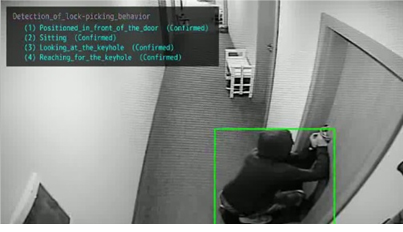
Detection of suspicious behavior
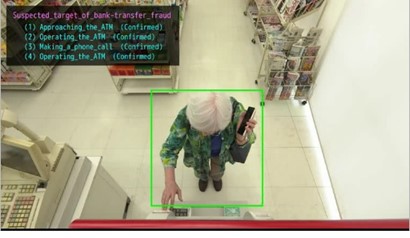
Detection of suspected target of bank transfer fraud
Applications beyond crime prevention
Fujitsu plans to exhibit its Actlyzer at the UN Congress on Crime Prevention and Criminal Justice (Kyoto Congress) in March 2021. Fujitsu considers the technology has useful applications for crime prevention and video surveillance by detecting actions related to lock-picking, bank transfer fraud, shoplifting and other criminal behavior.
Actlyzer is also applicable for public safety, retail, manufacturing and many other purposes. For example, on train station platforms, it can detect intrusion into dangerous areas. At stores, it can monitor customers' purchasing behavior and analyze their interest in products. At manufacturing sites, it can measure working hours and confirm work procedures. With this technology, Fujitsu is helping organizations improve operational security and achieve safer workplaces for employees.












